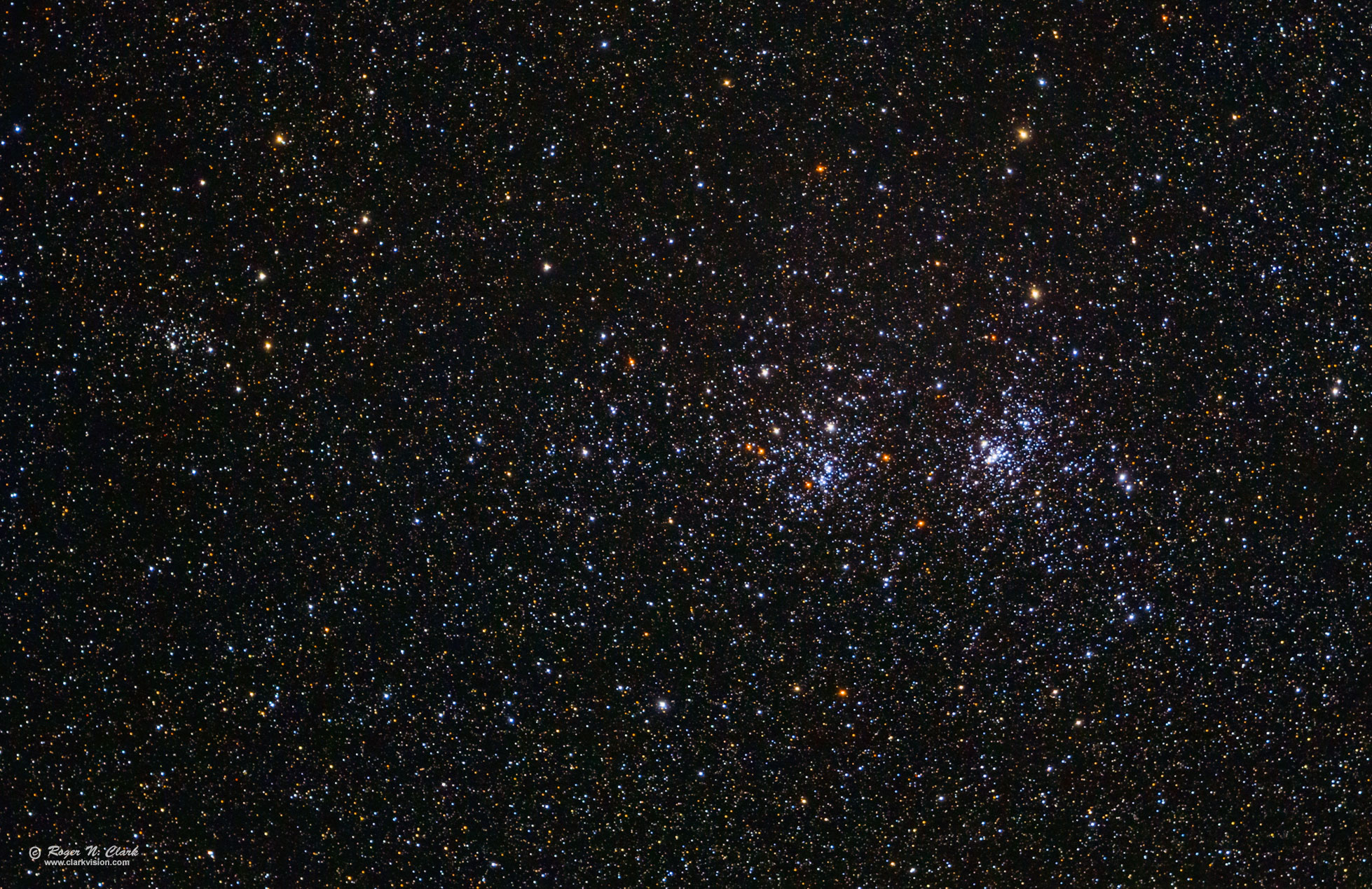| Home | Galleries | Articles | Reviews | Best Gear | New | About | Contact | Gallery Index | Previous |
Next |

| Home | Galleries | Articles | Reviews | Best Gear | New | About | Contact | Gallery Index | Previous |
Next |

The double cluster in Perseus is a nice sight in binoculars and small telescopes. The clusters designations are NGC 869 and 884. To the left is the small cluster NGC 957. The image is 12 minutes of exposure with a 300 mm f/2.8 lens and 7D Mark 1 camera and post processed with new free open source software that maintains color in astrophoto post processing. Note the many red, orange, yellow and blue stars--a part of the sky with amazing star color diversity. The white to blue stars are hotter, and the orange to red stars are cooler than our sun.
Technical. Canon 7D Mark I digital camera and 300 mm f/2.8 L IS II lens at f/2.8. 12 one-minute exposures at ISO 1600 were added (12 minutes total exposure). No dark frame subtraction, no flat fields, no noise reduction. Tracking with an astrotrac. This image is 50% of full resolution and is a crop. The upper left corner is the upper left corner of the camera image frame, so you can see the impressive star quality of this lens.
Post processing: stretched with rnc-color-stretch. Also see Astrophotography Image Processing Basic Work Flow.
Modern DSLRs like the 7D Mark I include on sensor dark current suppression and low fixed pattern noise at ISOs around 1600 and higher, making no need for dark frame subtraction. Modern raw converters correct for light fall-off and also correct for hot/dead/stuck pixels. This makes processing low light images easy: simply align and average.
This is a natural color image. The high dynamic range of astrophotos must be stretched to bring out the range of details the camera recorded. But the typical image stretch process loses color for brighter subjects (e.g. stars and the brighter parts of deep sky objects become whiter as they are made brighter). This image uses a new algorithm, rnc-color-stretch that does not lose color during the stretch. How do we know the colors are reasonable? The star colors can be checked against stellar photometry. The star color diversity is impressive in this region of the sky. Note the faint red stars, they have B-V > 2 (not the bright orange stars, which have B-V of 1 to 2). The blue-white stars have B-V in the range of 0 to -0.5. The colors closely follow the color sequence in Table 1 at Color of Stars. Solar-type stars have a B-V of 0.63 and appear close to white (daylight white balance).
The Exposure Factors, CEF, CEFA are measures of the relative amounts of light received from a subject. It can be used to fairly compare wildly different lens/telescope apertures and exposure times. For this image:
To learn how to obtain stunning images like this, please visit my Extensive Articles on Photography .
See my review of the Canon 7D Mark II and why it is so good for astrophotography: Canon 7D Mark II sensor analysis.
Keywords to this image = astrophoto-1 star_cluster night low-light digital_astro canon_7d2 rnc-color-stretch
Image ID: double-cluster.300mm-7d1c09.26.2014.IMG_2401-11.d0.5xc1s.jpg
| Home | Galleries | Articles | Reviews | Best Gear | Science | New | About | Contact |
Last updated November 03, 2025